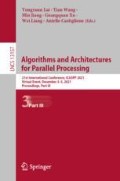Abstract
Deep convolutional neural networks (DCNNs) have achieved great success in various applications. Nevertheless, training and deploying such DCNNs models require a huge amount of computation and storage resources. Weight pruning has emerged as an effective compression technique for DCNNs to reduce the consumption of hardware resources. However, existing weight pruning schemes neglect to simultaneously consider accuracy, compression ratio and hardware-efficiency in the design space, which inevitably leads to performance degradation. To overcome these limitations, in this work, we propose a cooperative weight/activation compression approach. Initially, we observe spatially insensitive consistency, namely the insensitive weight values that have no impact on accuracy distributed at the same spatial position in a mass of channels. Based on the key observation, we propose a cluster-based weight pattern pruning technique, which converges the channels with spatially insensitive consistency into a cluster and prunes them into the weight pattern with a uniform shape. In addition, there are many sparsity rows in the activation matrix due to the effect of the activation function–Rectifying Linear Unit (ReLU). We study the sparsity rows and find that rows with larger sparsity degree are insensitive to accuracy. Hence, we further propose a sparsity-row-based activation removal technique, which directly eliminates insensitive rows of activation. The two proposed techniques allow the hardware to execute at excellent parallel granularity and achieve better compression ratio with negligible accuracy loss. Experiment results on several popular DCNNs models show that our scheme reduces the computation by \(63\%\) on average.
Access this chapter
Tax calculation will be finalised at checkout
Purchases are for personal use only
References
Krizhevsky, A., Sutskever, I., Hinton, G.E.: ImageNet classification with deep convolutional neural networks. In: Advances in Neural Information Processing Systems (NeurIPS) (2012)
Redmon, J., Divvala, S., Girshick, R., Farhadi, A.: You only look once: unified, real-time object detection. In: IEEE Conference on Computer Vision and Pattern Recognition (CVPR) (2016)
Amodei, D., et al.: Deep speech 2: end-to-end speech recognition in English and Mandarin. In: The International Conference on Machine Learning (ICML) (2016)
Jouppi, N.P., et al.: In-datacenter performance analysis of a tensor processing unit. In: Proceedings of the 44th Annual International Symposium on Computer Architecture (ISCA) (2017)
Akhlaghi, V., Yazdanbakhsh, A., Samadi, K., Gupta, R.K., Esmaeilzadeh, H.: SnaPEA: predictive early activation for reducing computation in deep convolutional neural networks. In: ACM/IEEE 45th Annual International Symposium on Computer Architecture (ISCA) (2018)
Simonyan, K., Zisserman, A.: Very deep convolutional networks for large-scale image recognition. In: International Conference on Learning Representations (ICLR) (2015)
Deng, J., Dong, W., Socher, R., Li, L.-J., Li, K., Fei-Fei, L.: ImageNet: a large-scale hierarchical image database. In: IEEE Conference on Computer Vision and Pattern Recognition (CVPR) (2009)
Wu, Y., Wang, Z., Shi, Y., Hu, J.: Enabling on-device CNN training by self-supervised instance filtering and error map pruning. IEEE Trans. Comput. Aided Des. Integr. Circ. Syst. 39(11) (2020)
Bateni, S., Liu, C.: NeuOS: a latency-predictable multi-dimensional optimization framework for DNN-driven autonomous systems. In: 2020 USENIX Annual Technical Conference (USENIX ATC) (2020)
Ma, X., et al.: PCONV: the missing but desirable sparsity in DNN weight pruning for real-time execution on mobile devices. In: Proceedings of the AAAI Conference on Artificial Intelligence (AAAI) (2020)
Han, S., Pool, J., Tran, J., Dally, W.: Learning both weights and connections for efficient neural network. In: NeurIPS (2015)
Han, S., Mao, H., Dally, W.J.: Deep compression: compressing deep neural networks with pruning, trained quantization and Huffman coding. arXiv preprint arXiv:1510.00149 (2015)
He, Y., Zhang, X., Sun, J.: Channel pruning for accelerating very deep neural networks. In: Proceedings of the IEEE International Conference on Computer Vision (ICCV) (2017)
Wen, W., Wu, C., Wang, Y., Chen, Y., Li, H.: Learning structured sparsity in deep neural networks. In: Advances in Neural Information Processing Systems (NeurIPS) (2016)
Yazdani, R., Riera, M., Arnau, J.-M., González, A.: The dark side of DNN pruning. In: 2018 ACM/IEEE 45th Annual International Symposium on Computer Architecture (ISCA) (2018)
Li, H., Kadav, A., Durdanovic, I., Samet, H., Graf, H.P.: Pruning filters for efficient convnets. arXiv preprint arXiv:1608.08710 (2016)
Niu, W.: PatDNN: achieving real-time DNN execution on mobile devices with pattern-based weight pruning. In: Proceedings of the Twenty-Fifth International Conference on Architectural Support for Programming Languages and Operating Systems (ASPLOS) (2020)
Mogers, N., Radu, V., Li, L., Turner, J., O’Boyle, M., Dubach, C.: Automatic generation of specialized direct convolutions for mobile GPUs. In: Proceedings of the 13th Annual Workshop on General Purpose Processing using Graphics Processing Unit (GPGPU) (2020)
LeCun, Y., Bottou, L., Bengio, Y., Haffner, P.: Gradient-based learning applied to document recognition. Proc. IEEE 86(11), 2278–2324 (1998)
Krizhevsky, A., Hinton, G.: Learning multiple layers of features from tiny images. Technical report, Citeseer (2009)
Acknowledgements
This research is supported by the grants from the National Science Foundation for Young Scientists of China (Grant No.61902218), the National Natural Science Foundation of China (Grant No. 92064008).
Author information
Authors and Affiliations
Corresponding author
Editor information
Editors and Affiliations
Rights and permissions
Copyright information
© 2022 Springer Nature Switzerland AG
About this paper
Cite this paper
Zhang, Y. et al. (2022). Accelerating DCNNs via Cooperative Weight/Activation Compression. In: Lai, Y., Wang, T., Jiang, M., Xu, G., Liang, W., Castiglione, A. (eds) Algorithms and Architectures for Parallel Processing. ICA3PP 2021. Lecture Notes in Computer Science(), vol 13157. Springer, Cham. https://doi.org/10.1007/978-3-030-95391-1_43
Download citation
DOI: https://doi.org/10.1007/978-3-030-95391-1_43
Published:
Publisher Name: Springer, Cham
Print ISBN: 978-3-030-95390-4
Online ISBN: 978-3-030-95391-1
eBook Packages: Computer ScienceComputer Science (R0)

